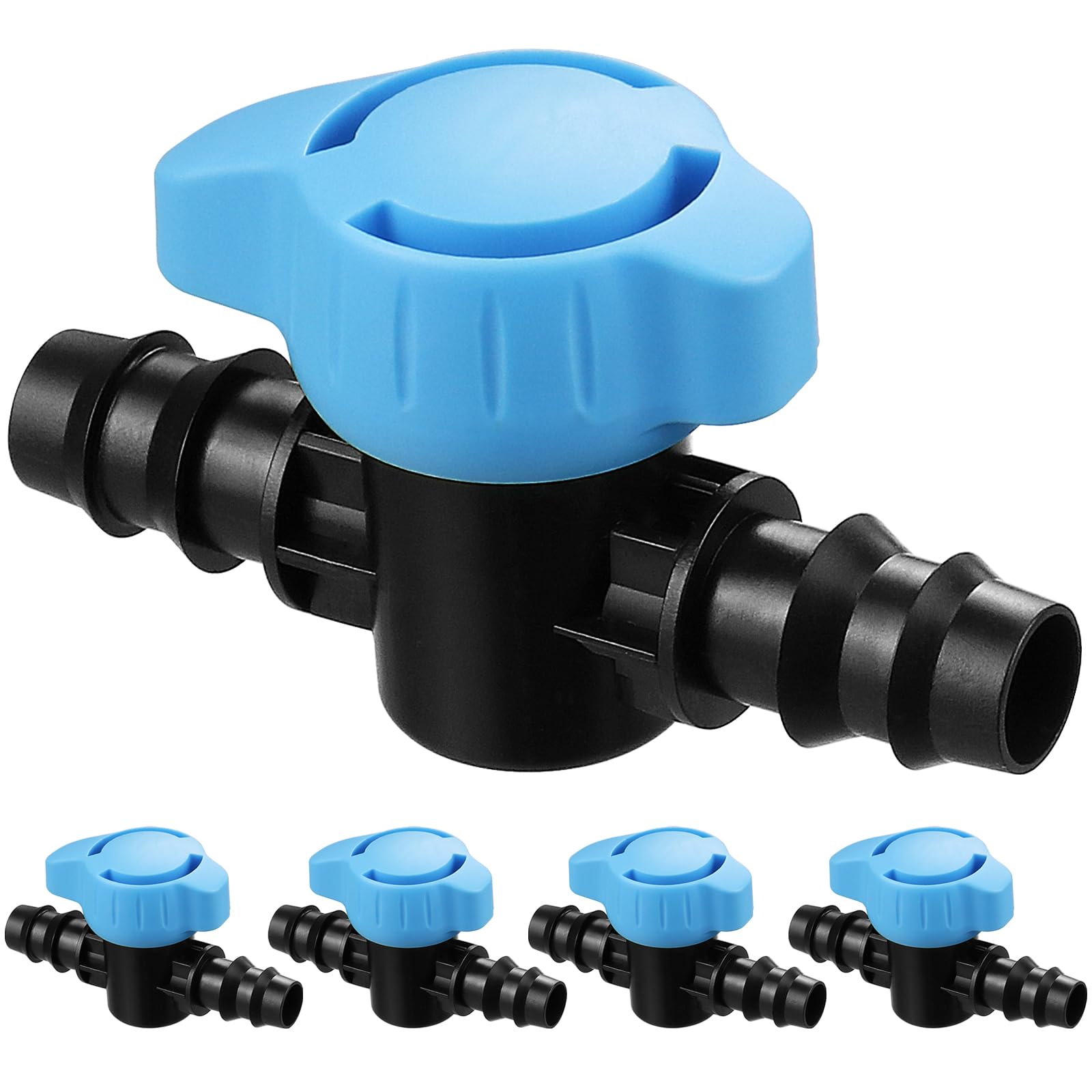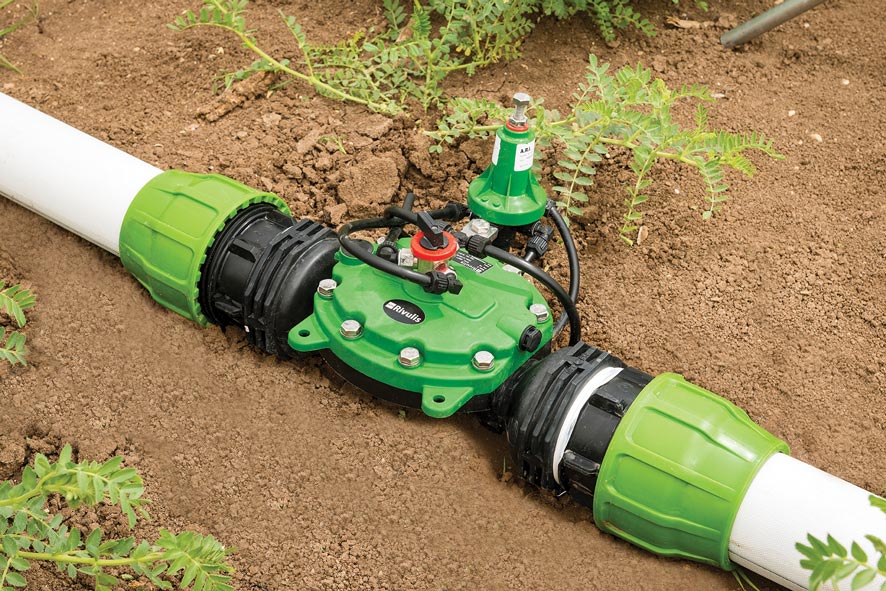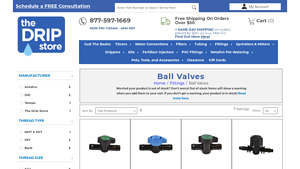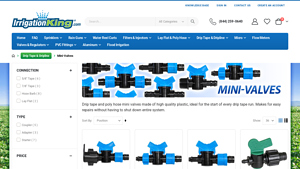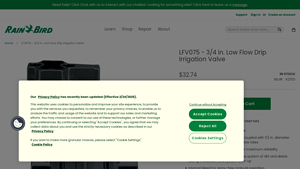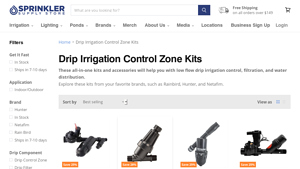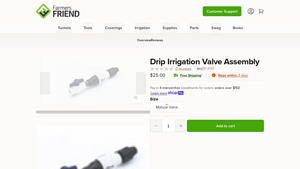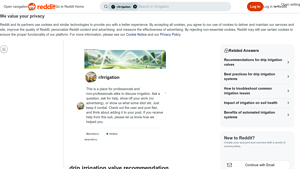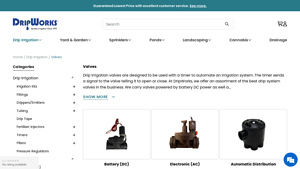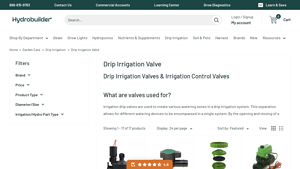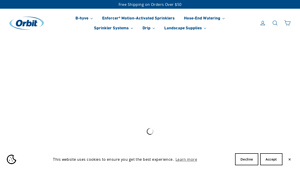Introduction: Navigating the Global Market for drip irrigation valves
In today’s rapidly evolving agricultural landscape, sourcing the right drip irrigation valves is crucial for optimizing water efficiency and enhancing crop yields. However, international buyers often face challenges in identifying high-quality products that meet diverse regional standards and operational requirements. This guide serves as a comprehensive resource for B2B buyers navigating the complex global market for drip irrigation valves.
We delve into various types of valves, including ball valves, mini-valves, and low-flow options, while exploring their specific applications across different agricultural settings. Understanding the functionalities and benefits of each valve type allows buyers to make informed decisions tailored to their unique irrigation needs. Moreover, we provide insights into effective supplier vetting processes, ensuring that you partner with reputable manufacturers who adhere to quality standards and deliver reliable products.
Additionally, the guide covers cost considerations and emerging trends in the drip irrigation sector, empowering buyers from regions such as Africa, South America, the Middle East, and Europe—countries like Vietnam and Brazil—to optimize their purchasing strategies. By leveraging the information presented here, B2B buyers can confidently navigate the global market, ensuring they select the most suitable drip irrigation valves to enhance their agricultural operations.
Understanding drip irrigation valves Types and Variations
| Type Name | Key Distinguishing Features | Primary B2B Applications | Brief Pros & Cons for Buyers |
|---|---|---|---|
| Ball Valves | Simple design, excellent flow control, durable materials | Agricultural irrigation, landscaping | Pros: Easy to operate, reliable sealing. Cons: May require more space for installation. |
| Mini-Valves | Compact size, suitable for low flow, often used with drip tape | Vegetable and flower gardens | Pros: Space-efficient, cost-effective. Cons: Limited flow capacity. |
| In-Line Valves | Integrated into irrigation lines, often automated | Large-scale agricultural systems | Pros: Reduces installation time, consistent pressure control. Cons: Higher initial investment. |
| Shut-Off Valves | Manual or automated control of water flow | Residential and commercial gardens | Pros: Simple to use, prevents water wastage. Cons: Can be prone to clogging if not maintained. |
| Pressure-Regulating Valves | Maintains consistent pressure, prevents system damage | High-value crops, sensitive plants | Pros: Protects irrigation systems, optimizes water usage. Cons: More complex, higher cost. |
What Are Ball Valves and Their Applications in B2B Purchases?
Ball valves are designed for effective flow control, featuring a spherical disc that can be rotated to open or close the flow. Their durability makes them suitable for various environments, particularly in agricultural irrigation and landscaping applications. B2B buyers should consider the ease of operation and reliability of sealing when purchasing ball valves, although the installation may require more space.
How Do Mini-Valves Benefit Small-Scale Irrigation?
Mini-valves are compact and designed for low flow applications, often used in conjunction with drip tape. They are particularly beneficial for vegetable and flower gardens where space is limited. Buyers looking for cost-effective solutions that do not compromise on performance will find mini-valves appealing, though their limited flow capacity may not suit larger operations.
What Are the Advantages of In-Line Valves for Large-Scale Systems?
In-line valves are integrated directly into irrigation lines and are often automated to ensure consistent pressure and flow. They are ideal for large-scale agricultural systems, where efficiency and reliability are critical. While they can save time during installation and provide consistent pressure control, the initial investment may be higher than other valve types.
Why Should Buyers Consider Shut-Off Valves?
Shut-off valves provide a straightforward means of controlling water flow, either manually or automatically. They are commonly used in both residential and commercial gardens to prevent water wastage. Buyers should appreciate their simplicity and effectiveness, although regular maintenance is necessary to avoid clogging issues.
What Role Do Pressure-Regulating Valves Play in Irrigation Systems?
Pressure-regulating valves are essential for maintaining consistent water pressure, thereby preventing damage to irrigation systems and optimizing water usage. They are particularly important for high-value crops and sensitive plants that require precise irrigation. While these valves offer significant benefits, their complexity and higher costs may be considerations for B2B buyers.
Key Industrial Applications of drip irrigation valves
| Industry/Sector | Specific Application of drip irrigation valves | Value/Benefit for the Business | Key Sourcing Considerations for this Application |
|---|---|---|---|
| Agriculture | Precision irrigation in crop production | Optimizes water use, enhances crop yield, and reduces costs | Compatibility with existing systems and local water sources |
| Horticulture | Water management in greenhouse operations | Ensures consistent moisture, leading to healthier plants | Durability against chemicals and UV exposure |
| Landscaping | Irrigation control for commercial landscapes | Enhances aesthetic appeal while conserving water | Flow rate specifications and ease of installation |
| Viticulture | Irrigation in vineyards | Supports grape quality and maximizes harvest | Pressure regulation and filtration options |
| Municipal Water Management | Urban irrigation systems | Improves water efficiency and reduces runoff | Compliance with local regulations and standards |
How Are Drip Irrigation Valves Used in Agriculture?
In agriculture, drip irrigation valves are essential for managing the precise delivery of water to crops. They help farmers optimize water use, significantly reducing wastage and ensuring that crops receive the right amount of moisture. This technology is particularly beneficial in regions facing water scarcity, such as parts of Africa and the Middle East. Buyers in this sector should consider compatibility with existing irrigation systems and local water sources when sourcing these valves.
What Role Do Drip Irrigation Valves Play in Horticulture?
In horticulture, drip irrigation valves are utilized to manage water delivery in greenhouse environments. By ensuring consistent moisture levels, these valves contribute to healthier plant growth and improved yields. This application is crucial in regions like South America, where climatic conditions can vary greatly. Buyers should prioritize the durability of valves against chemicals and UV exposure, ensuring they can withstand the greenhouse environment.
How Are Drip Irrigation Valves Beneficial for Landscaping?
Drip irrigation valves are widely used in commercial landscaping to control irrigation systems efficiently. They enhance the aesthetic appeal of landscapes while conserving water, making them an eco-friendly choice for urban planners. In regions like Europe, where sustainability is a growing concern, these valves can help meet environmental regulations. Key sourcing considerations include flow rate specifications and the ease of installation to ensure seamless integration into existing systems.
Why Are Drip Irrigation Valves Important in Viticulture?
In viticulture, drip irrigation valves play a critical role in managing water supply for vineyards. They ensure that grapevines receive adequate moisture, which is vital for grape quality and maximizing harvests. This application is particularly relevant in countries such as Brazil, where wine production is on the rise. Buyers should look for valves that offer pressure regulation and filtration options to maintain the quality of water supplied to the vines.
How Do Drip Irrigation Valves Improve Municipal Water Management?
Municipal water management systems benefit from drip irrigation valves by improving irrigation efficiency in urban areas. These valves help reduce water runoff and promote sustainable practices in city landscaping. In regions with strict water usage regulations, such as parts of Europe, sourcing valves that comply with local standards is essential. Buyers should ensure that the valves are designed to meet the specific requirements of urban irrigation systems.
3 Common User Pain Points for ‘drip irrigation valves’ & Their Solutions
Scenario 1: Inconsistent Water Flow Affects Crop Yield
The Problem: Many agricultural enterprises that rely on drip irrigation valves face the challenge of inconsistent water flow, which can lead to uneven moisture distribution in crops. This inconsistency often stems from using valves that are not specifically designed for low flow rates, resulting in certain areas receiving too much water while others remain dry. For B2B buyers, this issue not only threatens crop health but also impacts the overall profitability of their operations.
The Solution: To address this issue, B2B buyers should consider sourcing valves specifically designed for low flow applications, such as low flow drip irrigation valves with a unique diaphragm design. These valves can handle flow rates as low as 0.2 gallons per minute (gpm) without experiencing weeping or clogging. Buyers should ensure their suppliers offer detailed specifications and performance data to match the valve to their specific irrigation needs. Implementing a filtration system upstream of the valve can further enhance performance by preventing sediment from clogging the system, ensuring a consistent flow rate and even distribution of water across the field.
Scenario 2: Difficulty in Maintenance and Troubleshooting
The Problem: Maintenance of drip irrigation systems can be a daunting task, especially when valves malfunction or become clogged. B2B buyers often struggle with identifying the root cause of issues due to a lack of clear access points for inspection and maintenance. This can lead to prolonged downtimes and increased operational costs, as troubleshooting may require significant labor and time.
The Solution: To streamline maintenance processes, buyers should look for drip irrigation valves that incorporate user-friendly design features, such as external bleed valves for manual flushing. These features allow users to easily clear out debris and sediment without disassembling the entire system. Additionally, investing in smart irrigation technology can provide real-time data on system performance, enabling quicker identification of issues. Regular training for staff on valve operation and maintenance best practices can also help minimize downtime and ensure that any problems are resolved swiftly.
Scenario 3: Compatibility Issues with Existing Systems
The Problem: A common pain point for B2B buyers is the compatibility of new drip irrigation valves with existing systems. Many buyers find themselves in situations where the new valves do not fit the existing infrastructure, leading to costly modifications or complete system overhauls. This is particularly problematic for large agricultural operations or commercial landscaping companies that rely on seamless integration for efficiency.
The Solution: To mitigate compatibility issues, buyers should conduct a thorough assessment of their existing systems before purchasing new valves. This includes understanding the specific thread types, sizes, and connection methods currently in use. When sourcing new valves, it is advisable to consult with suppliers who can provide detailed compatibility charts or custom solutions tailored to existing setups. Additionally, selecting valves that offer flexible connection options, such as barb fittings or threaded connections, can provide the adaptability needed to integrate with various systems easily. By prioritizing compatibility in the procurement process, buyers can save time and resources while enhancing the overall efficiency of their irrigation systems.
Strategic Material Selection Guide for drip irrigation valves
What Are the Key Materials Used in Drip Irrigation Valves?
When selecting drip irrigation valves, the choice of material is crucial for performance, durability, and cost-effectiveness. Below, we analyze four common materials used in the manufacturing of these valves: PVC, brass, stainless steel, and polyethylene. Each material has unique properties that can significantly impact the effectiveness of the irrigation system.
How Does PVC Perform in Drip Irrigation Valves?
Key Properties: PVC (Polyvinyl Chloride) is known for its excellent chemical resistance and lightweight nature. It can typically withstand temperatures up to 140°F (60°C) and pressures of around 150 psi.
Pros & Cons: The advantages of PVC include its low cost and ease of installation, making it a popular choice for many agricultural applications. However, it can become brittle over time when exposed to UV light and extreme temperatures, leading to potential failures.
Impact on Application: PVC valves are compatible with a wide range of media, including water and fertilizers. However, they may not be suitable for high-pressure applications or extreme temperatures.
Considerations for International Buyers: Compliance with standards like ASTM is essential when sourcing PVC valves. Buyers in regions such as Africa and South America should consider local climate conditions that may affect the longevity of PVC products.
What Are the Benefits of Brass in Drip Irrigation Valves?
Key Properties: Brass is a durable alloy composed primarily of copper and zinc, offering excellent corrosion resistance and strength. It can handle high temperatures (up to 200°F or 93°C) and pressures exceeding 300 psi.
Pros & Cons: The main advantage of brass is its longevity and robustness, making it ideal for high-pressure systems. However, brass valves tend to be more expensive than PVC and may require additional maintenance to prevent corrosion over time.
Impact on Application: Brass valves are suitable for various media, including potable water and chemicals, making them versatile. They are particularly beneficial in areas with high salinity or corrosive soils.
Considerations for International Buyers: Brass valves often comply with international standards like DIN and JIS. Buyers should ensure that they are sourcing lead-free brass to meet health regulations, especially in Europe.
Why Choose Stainless Steel for Drip Irrigation Valves?
Key Properties: Stainless steel offers superior corrosion resistance and can withstand extreme temperatures and pressures, making it suitable for harsh environments. It typically operates effectively at temperatures up to 400°F (204°C) and pressures of 500 psi.
Pros & Cons: The durability and strength of stainless steel make it an excellent choice for long-term applications. However, it is the most expensive option among common materials and may require specialized fittings.
Impact on Application: Stainless steel valves are compatible with a wide range of media, including corrosive chemicals, making them ideal for specialized agricultural applications.
Considerations for International Buyers: Compliance with standards such as ASTM and ISO is critical. Buyers should also consider the cost implications of stainless steel in budget-sensitive markets like parts of Africa and South America.
What Role Does Polyethylene Play in Drip Irrigation Valves?
Key Properties: Polyethylene is a flexible, lightweight plastic that offers good chemical resistance and can operate within a temperature range of -40°F to 140°F (-40°C to 60°C).
Pros & Cons: The flexibility of polyethylene allows for easy installation and adaptability in various configurations. However, it may not be suitable for high-pressure applications and can degrade under UV exposure.
Impact on Application: Polyethylene valves are primarily used in low-pressure systems and are excellent for irrigation in regions with variable terrain.
Considerations for International Buyers: Buyers should ensure that polyethylene products meet local regulations and standards. In regions with high UV exposure, additional protective measures may be necessary.
Summary Table of Material Selection for Drip Irrigation Valves
| Material | Typical Use Case for drip irrigation valves | Key Advantage | Key Disadvantage/Limitation | Relative Cost (Low/Med/High) |
|---|---|---|---|---|
| PVC | General agricultural irrigation | Low cost and easy installation | Brittle over time, UV sensitivity | Low |
| Brass | High-pressure and corrosive environments | Durable and corrosion-resistant | Higher cost, potential for corrosion | Med |
| Stainless Steel | Harsh environments and chemical applications | Superior durability and strength | Most expensive, requires special fittings | High |
| Polyethylene | Low-pressure irrigation systems | Flexible and easy to install | Not suitable for high pressure, UV degradation | Low |
This guide provides a comprehensive overview of the materials available for drip irrigation valves, enabling international B2B buyers to make informed decisions based on their specific needs and local conditions.
In-depth Look: Manufacturing Processes and Quality Assurance for drip irrigation valves
What Are the Key Stages in the Manufacturing Process of Drip Irrigation Valves?
The manufacturing of drip irrigation valves involves several critical stages that ensure the production of high-quality, durable products. Understanding these stages can help B2B buyers assess the capabilities of potential suppliers.
Material Preparation: What Materials Are Used and How Are They Processed?
The first stage involves selecting the right materials, typically high-grade plastics or brass, depending on the valve type. Plastics like PVC and polyethylene are favored for their corrosion resistance and lightweight properties, while brass is often chosen for its durability and ability to withstand higher pressures.
Once the materials are selected, they undergo a thorough preparation process, which includes cleaning and drying to remove contaminants. This step is crucial to ensure that the final product adheres well and performs as intended.
How Are Drip Irrigation Valves Formed and Assembled?
The next stage is forming, where the prepared materials are molded into the valve shapes. This is typically achieved through injection molding for plastics, where molten material is injected into a mold and cooled to form the desired shape. For brass valves, machining processes such as turning and milling are employed.
After forming, the valves undergo assembly, where various components such as seals, diaphragms, and actuators are integrated. Automated assembly lines are often used to enhance precision and efficiency, ensuring that each valve operates smoothly and reliably.
What Finishing Techniques Are Commonly Used for Drip Irrigation Valves?
Finishing is the final stage of the manufacturing process, which may involve surface treatments like coatings or plating to improve corrosion resistance and aesthetic appeal. Quality checks are integral during this phase to identify any defects that may compromise the valve’s performance.
How Is Quality Assurance Implemented in the Production of Drip Irrigation Valves?
Quality assurance (QA) is a vital part of the manufacturing process, ensuring that the valves meet both international standards and customer specifications.
Which International Standards Are Relevant for Drip Irrigation Valves?
Many manufacturers adhere to international standards such as ISO 9001, which outlines the criteria for a quality management system. Compliance with these standards demonstrates a commitment to quality and customer satisfaction. Additionally, industry-specific certifications like CE marking in Europe and API standards for petroleum-related applications can indicate a product’s reliability and safety.
What Are the Key Quality Control Checkpoints During Manufacturing?
Quality control (QC) checkpoints are established at various stages of the manufacturing process:
Incoming Quality Control (IQC): This involves inspecting raw materials upon arrival to ensure they meet specified standards before production begins.
In-Process Quality Control (IPQC): During the manufacturing process, random samples are tested to monitor the production quality in real-time. This helps in identifying defects early, minimizing waste.
Final Quality Control (FQC): Once the valves are assembled, they undergo rigorous testing to ensure they meet operational specifications. This includes pressure testing, flow rate testing, and leak detection.
What Testing Methods Are Commonly Used to Ensure Product Quality?
Various testing methods are employed to validate the performance and durability of drip irrigation valves:
- Pressure Testing: Valves are subjected to high-pressure conditions to ensure they can withstand operational pressures without leaking.
- Flow Rate Testing: This assesses the valve’s ability to control water flow effectively, which is crucial for optimal irrigation.
- Durability Testing: Products may be exposed to extreme temperatures and environmental conditions to simulate long-term usage.
How Can B2B Buyers Verify Supplier Quality Control Processes?
For B2B buyers, particularly those in regions like Africa, South America, the Middle East, and Europe, verifying a supplier’s QC processes is essential to ensure product reliability.
What Methods Can Buyers Use to Audit and Inspect Suppliers?
Supplier Audits: Conducting on-site audits can provide insights into the manufacturing processes and QC measures in place. This allows buyers to assess compliance with international standards and best practices.
Requesting Quality Reports: Buyers should ask for detailed QC reports that outline testing results, certifications, and any corrective actions taken for defects.
Third-Party Inspections: Engaging third-party inspection agencies can provide an unbiased assessment of the manufacturing processes and product quality. These agencies typically follow standardized procedures to evaluate compliance.
What Are the Quality Control Nuances for International B2B Buyers?
International buyers must be aware of certain nuances when it comes to QC:
Regulatory Compliance: Different regions may have specific regulations governing product safety and quality. Understanding these requirements is crucial for avoiding compliance issues.
Cultural Considerations: In some regions, the emphasis on quality may vary. Buyers should be prepared to communicate their quality expectations clearly and ensure that suppliers understand these requirements.
Supply Chain Transparency: Establishing transparency in the supply chain can help buyers trace materials and components back to their sources, ensuring quality at every stage.
Conclusion: The Importance of Manufacturing Processes and Quality Assurance in Drip Irrigation Valves
In conclusion, understanding the manufacturing processes and quality assurance measures for drip irrigation valves is vital for B2B buyers. By knowing what to look for in terms of material preparation, forming, assembly, and finishing, as well as the relevant quality control standards and methods, buyers can make informed decisions. Ensuring supplier compliance with international standards and engaging in thorough audits and inspections can ultimately lead to the procurement of reliable and high-quality irrigation solutions.
Practical Sourcing Guide: A Step-by-Step Checklist for ‘drip irrigation valves’
Introduction
This guide serves as a practical checklist for B2B buyers looking to procure drip irrigation valves. Understanding the critical elements of sourcing can enhance operational efficiency, reduce costs, and ensure compatibility with your irrigation systems. Follow these steps to make informed purchasing decisions that align with your specific agricultural or landscaping needs.
Step 1: Define Your Technical Specifications
Establishing clear technical specifications is essential for ensuring the valves meet your system’s requirements. Consider factors such as flow rates, pressure ratings, and compatibility with existing irrigation components. This step helps prevent costly errors and ensures that the valves will operate effectively within your irrigation setup.
- Flow Rates: Identify the necessary flow rates for your application, as valves are designed for specific flow capacities.
- Pressure Ratings: Confirm the pressure requirements to avoid valve failure or inefficiencies.
Step 2: Research Different Valve Types
Not all drip irrigation valves are created equal; each type serves different purposes. Familiarize yourself with the various valve types, such as ball valves, shut-off valves, and anti-siphon valves, to determine which best suits your needs. Understanding these distinctions can lead to better system performance and longevity.
- Ball Valves: Ideal for on/off control in low-flow situations.
- Shut-off Valves: Useful for isolating sections of your irrigation system for maintenance.
Step 3: Evaluate Potential Suppliers
Before committing to a supplier, thorough evaluation is crucial. Look for suppliers with a strong reputation in the industry, and request information such as company profiles, product certifications, and case studies. This due diligence helps ensure you are partnering with a reliable source.
- References: Ask for references from clients in similar industries or geographic regions to gauge supplier reliability.
- Certifications: Verify if the supplier has relevant industry certifications that demonstrate quality and compliance.
Step 4: Assess Quality and Durability
Investing in high-quality valves will pay off in the long run through reduced maintenance costs and fewer system failures. Examine the materials used in the valve construction, as well as any warranties offered. Valves made from robust materials are more likely to withstand environmental stresses, especially in harsh climates.
- Material Quality: Look for valves made from corrosion-resistant materials like PVC or brass.
- Warranty Options: A strong warranty can indicate the manufacturer’s confidence in their product’s durability.
Step 5: Compare Pricing and Total Cost of Ownership
While it can be tempting to choose the lowest-priced option, it’s important to consider the total cost of ownership. This includes installation costs, maintenance expenses, and potential downtime. Compare prices across multiple suppliers while factoring in these elements for a comprehensive evaluation.
- Initial Costs vs. Long-Term Value: Balance upfront costs with expected longevity and maintenance needs.
- Volume Discounts: Inquire about bulk purchasing options to maximize savings.
Step 6: Verify After-Sales Support and Service
Reliable after-sales support can be a significant advantage when sourcing drip irrigation valves. Ensure that the supplier offers technical support, installation guidance, and easy access to replacement parts. This support can save time and resources, especially when troubleshooting issues.
- Technical Assistance: Check if the supplier provides installation manuals or online resources.
- Availability of Spare Parts: Confirm that spare parts are readily available to minimize downtime.
Step 7: Finalize the Purchase Agreement
Once you have selected a supplier, ensure that the purchase agreement is clear and comprehensive. The agreement should outline delivery timelines, payment terms, and warranty details. A well-defined contract protects your investment and sets clear expectations for both parties.
- Delivery Timelines: Specify the expected delivery dates to ensure timely project completion.
- Payment Terms: Agree on payment conditions that suit your financial planning.
By following this checklist, B2B buyers can make informed decisions when sourcing drip irrigation valves, ultimately leading to enhanced efficiency and productivity in their irrigation systems.
Comprehensive Cost and Pricing Analysis for drip irrigation valves Sourcing
What Are the Key Cost Components of Drip Irrigation Valves?
When sourcing drip irrigation valves, understanding the cost structure is essential for B2B buyers. The main cost components include:
Materials: The choice of materials directly impacts the price. Common materials include PVC, brass, and polyethylene, each varying in cost and suitability for different environments. High-quality, durable materials often command a premium but can reduce replacement costs over time.
Labor: Labor costs can differ significantly based on the region of production. Labor-intensive manufacturing processes, such as machining brass valves, may increase costs. In contrast, automated processes in regions with lower labor costs can provide more competitive pricing.
Manufacturing Overhead: This encompasses all indirect costs associated with production, such as utilities, rent, and administrative expenses. Efficient operations can help minimize these costs, allowing for more competitive pricing.
Tooling: Investment in tooling is crucial for producing high-quality valves. Custom molds or specialized machinery can raise initial costs but may lead to better long-term profitability through improved product consistency.
Quality Control (QC): Rigorous QC processes ensure product reliability and compliance with international standards. While implementing robust QC can increase costs, it often results in fewer defects and returns, ultimately benefiting the buyer.
Logistics: Shipping and handling costs can significantly affect the total cost, particularly for international buyers. Factors such as distance, mode of transportation, and customs clearance can all contribute to logistics expenses.
Margin: Supplier profit margins vary widely based on market competition and perceived value. Understanding the margin can provide insight into pricing flexibility during negotiations.
What Influences Pricing of Drip Irrigation Valves?
Several factors can influence the pricing of drip irrigation valves, particularly for international B2B buyers:
Volume/MOQ: Bulk purchasing often leads to lower per-unit costs. Establishing a Minimum Order Quantity (MOQ) can be advantageous for negotiating better prices.
Specifications and Customization: Customized valves tailored to specific agricultural needs may incur additional costs. However, the right customization can enhance system efficiency and water savings, providing long-term value.
Materials and Quality Certifications: Products certified for quality and safety standards may be priced higher, but they offer assurance and reliability, especially in regions with stringent regulations.
Supplier Factors: The reputation and reliability of suppliers can affect pricing. Established suppliers with proven track records may charge higher prices but offer better service and reliability.
Incoterms: Understanding Incoterms (International Commercial Terms) is crucial for pricing transparency in international transactions. Terms such as FOB (Free on Board) or CIF (Cost, Insurance, and Freight) can impact the overall cost structure.
How Can Buyers Optimize Costs When Sourcing Drip Irrigation Valves?
To ensure cost-efficiency in sourcing drip irrigation valves, buyers should consider the following strategies:
Negotiation: Engaging in direct negotiations with suppliers can lead to better pricing, especially when discussing bulk orders or long-term contracts. Be prepared to share your purchasing forecasts to strengthen your position.
Total Cost of Ownership (TCO): Assessing the TCO involves evaluating not just the purchase price but also installation, maintenance, and replacement costs over the product’s lifespan. Investing in higher-quality valves can lead to lower TCO by reducing maintenance needs.
Pricing Nuances for International Buyers: Buyers from regions like Africa, South America, the Middle East, and Europe should be aware of currency fluctuations and import duties that can affect overall costs. Establishing relationships with local suppliers can mitigate some of these challenges.
Market Research: Conducting thorough market research on prevailing prices and supplier options can empower buyers to make informed decisions and avoid overpaying.
Conclusion
Sourcing drip irrigation valves requires a comprehensive understanding of cost components and price influencers. By strategically negotiating and considering the total cost of ownership, international B2B buyers can ensure they make economically sound decisions that support their agricultural needs. Keep in mind that prices can fluctuate based on market conditions, and buyers should always seek updated quotes from suppliers to ensure accuracy.
Alternatives Analysis: Comparing drip irrigation valves With Other Solutions
Understanding Alternatives in Drip Irrigation Solutions
In the realm of agriculture and horticulture, particularly in regions with scarce water resources, effective irrigation is crucial. Drip irrigation valves are a popular choice for precise water delivery directly to the plant roots. However, buyers should consider alternative solutions that might better meet their specific operational needs, budget constraints, or environmental conditions. This analysis compares drip irrigation valves with two viable alternatives: sprinkler systems and surface irrigation.
Comparison of Drip Irrigation Valves with Alternative Solutions
| Comparison Aspect | Drip Irrigation Valves | Sprinkler Systems | Surface Irrigation |
|---|---|---|---|
| Performance | High efficiency; minimizes water waste | Good coverage but can lead to evaporation losses | Can be inefficient with water use; relies on gravity |
| Cost | Moderate initial investment; low operational costs | Higher initial costs for installation and equipment | Low initial setup cost; higher labor costs for management |
| Ease of Implementation | Requires careful planning and installation | Generally easier to install; adaptable to various layouts | Simple to implement; requires less technology |
| Maintenance | Requires regular checks for clogs and leaks | Needs periodic maintenance; risk of malfunction | Minimal maintenance; however, soil management is essential |
| Best Use Case | Ideal for row crops and high-value plants needing precise watering | Suitable for lawns, gardens, and large fields | Effective for flood-prone areas or where water is abundant |
Detailed Breakdown of Alternatives
Sprinkler Systems: What Are Their Advantages and Disadvantages?
Sprinkler systems distribute water through a network of pipes and spray heads, providing broad coverage. They are particularly advantageous in larger agricultural setups or for landscaping where uniform water distribution is essential. However, they can lead to water loss through evaporation and wind drift, especially in hot climates. The initial investment can be significant, and they require regular maintenance to ensure all components function correctly.
Surface Irrigation: How Does It Compare?
Surface irrigation is a more traditional method involving the application of water directly to the soil surface, allowing it to flow over the field by gravity. This method is cost-effective and easy to implement, particularly in flat terrains. However, it can be inefficient in terms of water usage, as it often leads to runoff and evaporation. Additionally, it requires careful soil management to prevent erosion and maintain fertility.
Conclusion: How Should B2B Buyers Choose the Right Irrigation Solution?
When selecting an irrigation solution, B2B buyers should carefully assess their specific requirements, including crop type, water availability, and budget constraints. Drip irrigation valves offer precision and efficiency but may require a higher initial investment and ongoing maintenance. Sprinkler systems provide broader coverage but can lead to water loss, while surface irrigation is cost-effective but less efficient. Understanding these factors will empower buyers to make informed decisions that align with their agricultural goals and environmental conditions.
Essential Technical Properties and Trade Terminology for drip irrigation valves
What Are the Essential Technical Properties of Drip Irrigation Valves?
When sourcing drip irrigation valves, understanding their technical specifications is crucial for ensuring compatibility and performance in agricultural applications. Here are some key properties to consider:
Material Grade
The material of the valve impacts its durability and resistance to environmental factors. Common materials include PVC, polyethylene, and brass. PVC is lightweight and resistant to chemicals, making it suitable for various climates. Brass offers superior strength and longevity, especially in high-pressure systems. For B2B buyers, selecting the right material grade can minimize maintenance costs and improve system reliability.Flow Rate
Measured in gallons per minute (GPM) or liters per minute (LPM), the flow rate indicates the volume of water a valve can handle. For drip irrigation systems, valves typically operate effectively within a low flow range, often from 0.2 to 8 GPM. Understanding flow rate is essential for ensuring the valve meets the irrigation needs of specific crops and prevents water wastage.Pressure Rating
Valves are designed to function within specific pressure ranges, usually from 15 to 150 psi (1.0 to 10.3 bars). This rating determines the valve’s ability to withstand system pressure without failure. Selecting a valve with the appropriate pressure rating is vital for operational safety and efficiency, particularly in regions with varying water supply pressures.Connection Types
Different connection types, such as barbed, threaded, or slip fittings, dictate how valves integrate into existing irrigation systems. Understanding the connection type is crucial for ensuring compatibility with other components, thus facilitating a seamless installation process. B2B buyers should verify the connection specifications to avoid costly modifications.Operating Temperature Range
The operating temperature range indicates the extremes within which a valve can function effectively. Most drip irrigation valves operate well within a range of 0°C to 50°C (32°F to 122°F). For buyers, this property is essential for ensuring that valves perform adequately in the climatic conditions of their specific regions.Diaphragm Type
The diaphragm type affects the valve’s ability to handle particulates in low-flow scenarios. A unique “double-knife” diaphragm, for instance, allows for flawless operation at low flow rates, preventing weeping and ensuring reliable performance. Understanding diaphragm types can help buyers select valves that best suit their water quality and irrigation system requirements.
What Are Common Trade Terms Related to Drip Irrigation Valves?
Familiarity with industry jargon can streamline the purchasing process and enhance communication with suppliers. Here are some essential trade terms:
OEM (Original Equipment Manufacturer)
An OEM refers to companies that produce parts or equipment that may be marketed by another manufacturer. When sourcing valves, knowing if a supplier is an OEM can assure buyers of product quality and compatibility with existing systems.MOQ (Minimum Order Quantity)
MOQ is the smallest quantity of a product that a supplier is willing to sell. Understanding the MOQ is crucial for B2B buyers to manage inventory levels and budget constraints effectively, especially when entering new markets or launching projects.RFQ (Request for Quotation)
An RFQ is a document issued by a buyer to solicit price quotes from suppliers. It details the specifications and quantities required. Utilizing RFQs can help buyers compare pricing and terms across multiple suppliers, ensuring they receive competitive offers.Incoterms (International Commercial Terms)
Incoterms define the responsibilities of buyers and sellers in international transactions, including shipping and delivery responsibilities. Understanding Incoterms is vital for B2B buyers, particularly when importing valves from overseas manufacturers, as it helps clarify cost allocations and risk management.Lead Time
Lead time refers to the period between placing an order and receiving the goods. For agricultural operations that depend on timely irrigation solutions, understanding lead times is essential for planning and ensuring that systems are operational when needed.Warranty Period
The warranty period is the duration during which a product is guaranteed against defects. Knowing the warranty terms can help buyers assess the long-term reliability of drip irrigation valves and make informed purchasing decisions.
By grasping these technical properties and trade terms, B2B buyers can make more informed decisions when sourcing drip irrigation valves, ultimately enhancing their irrigation system’s efficiency and reliability.
Navigating Market Dynamics and Sourcing Trends in the drip irrigation valves Sector
What Are the Key Trends Shaping the Drip Irrigation Valves Market?
The global drip irrigation valves market is witnessing substantial growth, driven by increasing agricultural productivity demands and water scarcity issues. As regions like Africa, South America, and the Middle East face severe water shortages, the need for efficient irrigation solutions has surged. The adoption of precision farming techniques is another crucial driver, enabling farmers to optimize water use, enhance crop yields, and reduce operational costs. In this landscape, international B2B buyers are increasingly looking for advanced technologies such as automated and remotely controlled valves, which facilitate real-time monitoring and adjustments in irrigation systems.
Emerging sourcing trends highlight the importance of integrated supply chains that prioritize efficiency and responsiveness. Manufacturers are leveraging digital platforms to streamline procurement processes, enhance inventory management, and facilitate direct communication with buyers. Additionally, innovations such as IoT-enabled drip irrigation systems are gaining traction, offering features like data analytics and predictive maintenance. These advancements not only improve operational efficiency but also support sustainable agricultural practices, appealing to environmentally conscious buyers.
How Important Is Sustainability and Ethical Sourcing in the Drip Irrigation Valves Sector?
Sustainability and ethical sourcing have become pivotal considerations for B2B buyers in the drip irrigation valves sector. The environmental impact of agricultural practices necessitates a shift toward more sustainable solutions that minimize water waste and energy consumption. Buyers are increasingly seeking products that utilize eco-friendly materials and processes, leading to a rise in demand for valves made from recyclable or biodegradable materials.
Furthermore, the importance of ethical supply chains cannot be overstated. Buyers are now more inclined to partner with manufacturers who demonstrate transparency in their sourcing practices and adhere to fair labor standards. Certifications such as ISO 14001 for environmental management and various green product certifications serve as indicators of a manufacturer’s commitment to sustainability. For international buyers, particularly in regions with strict environmental regulations, these certifications are essential in ensuring compliance and maintaining a competitive edge in the market.
What Is the Historical Evolution of Drip Irrigation Valves?
The evolution of drip irrigation valves has been closely tied to advancements in agricultural practices and technology. Initially developed in the 1960s, drip irrigation systems were designed to improve water efficiency in arid regions. Early valves were rudimentary, often leading to issues such as clogging and inconsistent flow rates. However, as the demand for efficient irrigation solutions grew, manufacturers began innovating, introducing features like pressure regulation and filtration systems.
By the 1990s, the integration of electronic controls and automation transformed the landscape, allowing for more precise water management. Today, modern drip irrigation valves are equipped with advanced technologies that enhance performance and adaptability to various agricultural needs. This historical progression underscores the importance of continuous innovation in meeting the evolving demands of international B2B buyers, particularly in developing regions where agriculture is a key economic driver.
Frequently Asked Questions (FAQs) for B2B Buyers of drip irrigation valves
1. How do I solve issues with low flow rates in drip irrigation systems?
To resolve low flow rate issues in drip irrigation systems, ensure that you are using valves specifically designed for low flow applications, such as those with a “double-knife” diaphragm. These valves can handle low flow rates effectively and prevent weeping, ensuring a consistent water supply. Additionally, check for any blockages in the system, such as dirt or debris in filters, and ensure that the pressure is within the recommended range for your specific irrigation system.2. What is the best type of valve for drip irrigation?
The best type of valve for drip irrigation is typically a low-flow valve designed to handle specific flow rates without weeping. Look for valves that feature a robust diaphragm design and external bleed options to flush out dirt easily. Brands like Rain Bird and DIG offer specialized low-flow valves that can efficiently manage the unique demands of drip irrigation systems, ensuring optimal performance and water efficiency.3. How can I vet suppliers for drip irrigation valves internationally?
When vetting suppliers for drip irrigation valves, start by checking their certifications and compliance with international quality standards. Review their product range and ensure they have experience in the specific type of valves you need. Request references from other B2B buyers and check online reviews. Additionally, consider conducting a factory visit or using third-party inspection services to verify their production capabilities and quality control processes.4. What are the typical minimum order quantities (MOQs) for drip irrigation valves?
Minimum order quantities (MOQs) for drip irrigation valves can vary significantly depending on the supplier and the type of valve. Generally, MOQs range from 100 to 1,000 units. It’s essential to discuss MOQs directly with potential suppliers to understand their policies. Some suppliers may offer flexibility for first-time buyers or for bulk orders, while others may have strict limits based on their production capacity.5. What payment terms should I expect when sourcing drip irrigation valves?
Payment terms for sourcing drip irrigation valves typically include options such as advance payment, letter of credit, or payment upon delivery. Many suppliers may request a deposit (usually 30-50%) upon order confirmation, with the balance due before shipping. Always clarify payment terms upfront and consider negotiating for better terms, especially if you are establishing a long-term partnership or placing a large order.6. How do I ensure quality assurance (QA) for drip irrigation valves?
To ensure quality assurance for drip irrigation valves, request detailed product specifications and certifications from suppliers. Consider implementing a quality control process that includes pre-shipment inspections, where third-party agencies can verify that the products meet your specifications. Additionally, establish clear return policies and warranty agreements to safeguard your investment against defective products.7. What logistics considerations should I keep in mind when importing valves?
When importing drip irrigation valves, consider logistics factors such as shipping methods, customs duties, and delivery timelines. Choose reliable shipping partners who can handle the specific requirements of your products. Be aware of any import regulations in your country, and ensure that all documentation, including bills of lading and customs declarations, is accurate to avoid delays. Additionally, factor in potential lead times for manufacturing and shipping.8. Can I customize drip irrigation valves for specific agricultural needs?
Yes, many suppliers offer customization options for drip irrigation valves to meet specific agricultural needs. You can request changes in size, connection types, and flow rates based on your irrigation system requirements. When discussing customization, provide detailed specifications and be prepared for potential minimum order requirements or longer lead times due to the production process. Always confirm the feasibility and costs associated with customization before placing your order.
Important Disclaimer & Terms of Use
⚠️ Important Disclaimer
The information provided in this guide, including content regarding manufacturers, technical specifications, and market analysis, is for informational and educational purposes only. It does not constitute professional procurement advice, financial advice, or legal advice.
While we have made every effort to ensure the accuracy and timeliness of the information, we are not responsible for any errors, omissions, or outdated information. Market conditions, company details, and technical standards are subject to change.
B2B buyers must conduct their own independent and thorough due diligence before making any purchasing decisions. This includes contacting suppliers directly, verifying certifications, requesting samples, and seeking professional consultation. The risk of relying on any information in this guide is borne solely by the reader.
Top 9 Drip Irrigation Valves Manufacturers & Suppliers List
1. Drip Irrigation – Key Product
Domain: dripirrigation.com
Registered: 1997 (28 years)
Introduction: Key Product Details:
– Product Types: Ball Valves
– Featured Products:
– A007 Barbed Ball Valve for .700 or 17mm OD Poly Tube – Regular Price: $2.10
– A122 17mm Barbed Ball Valve – Regular Price: $2.86
– A047 3/4″ Barbed Ball Valve – Regular Price: $3.78
– A018 1/4″ Barbed Ball Valve – Regular Price: $0.61
– A020 Ball Valve 3/4″ FHT x MHT – Regular Price: $2.10
– A130 3/4″ FPT x 1/2″ …
2. Irrigation King – Drip Tape Mini-Valves
Domain: irrigationking.com
Registered: 2016 (9 years)
Introduction: Drip Tape Mini-Valves made of high quality plastic, ideal for the start of every drip tape run. Allows for easy repairs without shutting down the entire system. Various types available including Starter Mini-Valve Lay Flat Hose x 5/8″ Tape Swivel (RKMV17LF2), Starter Mini-Valve 10 mm locking Insert x 5/8″ Tape Swivel (RKMV1317), Starter Mini-Valve 10 mm Barb x 5/8″ Tape Swivel (RKMV1017), Starter …
3. Rain Bird – LFV075 Low Flow Drip Irrigation Valve
Domain: store.rainbird.com
Registered: 1995 (30 years)
Introduction: {“model”:”LFV075″,”type”:”3/4 in. Low Flow Drip Irrigation Valve”,”special_price”:”$32.74″,”list_price”:”$43.65″,”flow_range”:”0.2 to 8 gpm (0.6 to 30 l/m)”,”pressure_range”:”15 to 150 psi (1.0 to 10.3 bars)”,”electrical_specifications”:{“voltage”:”24 VAC”,”frequency”:”50/60 Hz”,”inrush_current”:”0.30 A (7.2 VA) at 60 Hz”,”holding_current”:”0.19 A (4.56 VA)”},”features”:[“Unique ‘double-knife’ dia…
4. Netafim – Low Flow Control Zone Kit
Domain: sprinklersupplystore.com
Registered: 2010 (15 years)
Introduction: Drip Irrigation Control Zone Kits include various models from brands like Rainbird, Hunter, and Netafim. Key products include: 1. Netafim LVCZ10075-LF – Low Flow Control Zone Kit: 1″ FPT Inlet x 3/4″ MPT Outlet, designed for dripperline, drip, and micro-spray zones. Original Price: $133.03, Current Price: $99.78. 2. Hunter HY075 – 3/4″ NPT WYE Filter: Replacement WYE Filter Assembly for ACZ-075 Dr…
5. Farmers Friend – Drip Irrigation Valve Assembly
Domain: farmersfriend.com
Registered: 2004 (21 years)
Introduction: {“product_name”: “Drip Irrigation Valve Assembly”, “SKU”: “FF-2747”, “price”: “$25.00”, “shipping”: “Free Shipping”, “shipping_time”: “Ships within: 3 days”, “reviews”: {“rating”: “0.00 out of 5 stars”, “count”: “0 reviews”}, “payment_options”: “Pay in 4 interest-free installments for orders over $50”, “product_options”: {“size”: [“Manual Valve”, “Decrement”, “Increment”]}, “related_products”: [{“…
6. Hunter – Drip Zone Kits
Domain: reddit.com
Registered: 2005 (20 years)
Introduction: Recommended brands: Hunter, Rainbird. Suggested addition of filter/regulator after the valve, referred to as drip zone kits. Working pressure range for drip irrigation: 15-50 psi, with regulators reducing pressure to 40 psi. Consideration for large zones (1000+ ft) where pressure loss may occur naturally without a regulator. Typical flow rates mentioned: 25+ gpm.
7. DripWorks – Drip Irrigation Valves
Domain: dripworks.com
Registered: 1998 (27 years)
Introduction: Drip irrigation valves are designed to be used with a timer to automate an irrigation system. They can be powered by battery DC power or household AC current, and there are also automatic distribution valves powered by water flow. Important installation notes include: do not use pipe dope around automated valves, always install a filter before the valves, install valves in a horizontal position, a…
8. DIG – Pressure Regulators
Domain: hydrobuilder.com
Registered: 2010 (15 years)
Introduction: Brand: DIG, FloraFlex, Netafim; Price Range: $ – $; Product Type: Irrigation Supplies; Diameter/Size: 17 mm, 3/4 Inch, 2 Inch; Irrigation/Hydro Part Type: Pressure Regulators, Valves, Disc Filter, Screen Filter.
9. Orbit – Top Underground Valves
Domain: orbitonline.com
Registered: 1999 (26 years)
Introduction: Top Underground Valves for Sprinkler and Drip Systems
Strategic Sourcing Conclusion and Outlook for drip irrigation valves
What Are the Key Takeaways for B2B Buyers in Drip Irrigation Valves?
In summary, strategic sourcing of drip irrigation valves is essential for optimizing water management and enhancing agricultural productivity. Buyers should focus on quality, compatibility, and supplier reliability to ensure efficient irrigation systems. Understanding the various types of valves, such as low-flow options and mini-valves, can lead to significant cost savings and improved system performance. Additionally, leveraging bulk purchasing and local partnerships can enhance supply chain efficiency, particularly in emerging markets across Africa, South America, the Middle East, and Europe.
How Can International Buyers Enhance Their Sourcing Strategy?
As the demand for sustainable agriculture practices grows, international buyers must remain proactive in identifying suppliers that prioritize innovation and sustainability. Engaging with manufacturers who offer comprehensive solutions, including control zone kits and filtration systems, will provide a competitive edge in the market.
What’s Next for B2B Buyers in the Drip Irrigation Sector?
Moving forward, it’s crucial for buyers to stay informed about technological advancements and market trends in drip irrigation. By actively participating in industry forums and seeking collaborative opportunities, businesses can not only enhance their sourcing strategies but also contribute to the global movement towards efficient water use in agriculture. Embrace the future of irrigation by investing in high-quality valves that align with your sustainability goals and operational needs.

